sensor INFINITI QX50 2020 Owners Manual
[x] Cancel search | Manufacturer: INFINITI, Model Year: 2020, Model line: QX50, Model: INFINITI QX50 2020Pages: 580, PDF Size: 7.43 MB
Page 433 of 580
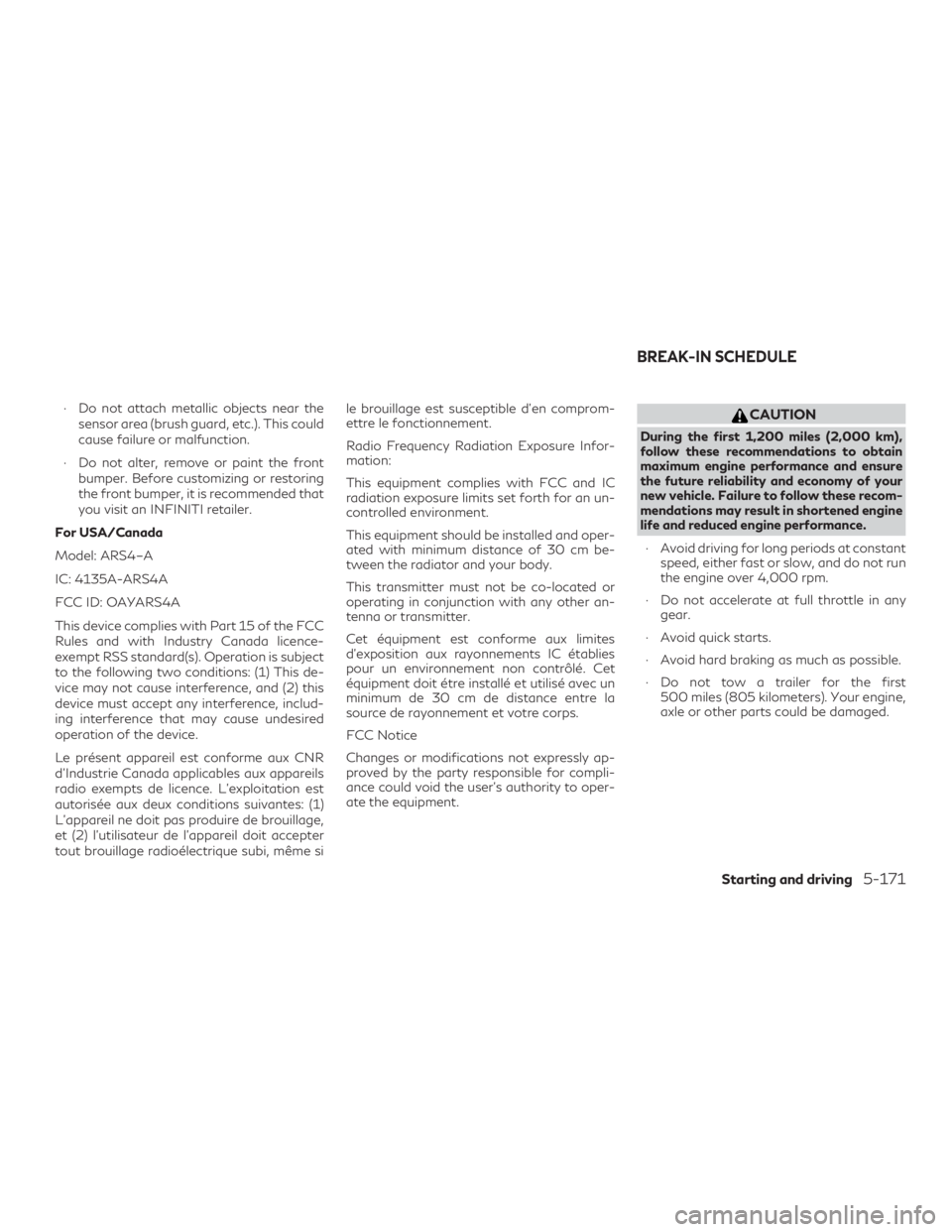
∙ Do not attach metallic objects near thesensor area (brush guard, etc.). This could
cause failure or malfunction.
∙ Do not alter, remove or paint the front bumper. Before customizing or restoring
the front bumper, it is recommended that
you visit an INFINITI retailer.
For USA/Canada
Model: ARS4–A
IC: 4135A-ARS4A
FCC ID: OAYARS4A
This device complies with Part 15 of the FCC
Rules and with Industry Canada licence-
exempt RSS standard(s). Operation is subject
to the following two conditions: (1) This de-
vice may not cause interference, and (2) this
device must accept any interference, includ-
ing interference that may cause undesired
operation of the device.
Le présent appareil est conforme aux CNR
d’Industrie Canada applicables aux appareils
radio exempts de licence. L’exploitation est
autorisée aux deux conditions suivantes: (1)
L’appareil ne doit pas produire de brouillage,
et (2) l’utilisateur de l’appareil doit accepter
tout brouillage radioélectrique subi, même si le brouillage est susceptible d’en comprom-
ettre le fonctionnement.
Radio Frequency Radiation Exposure Infor-
mation:
This equipment complies with FCC and IC
radiation exposure limits set forth for an un-
controlled environment.
This equipment should be installed and oper-
ated with minimum distance of 30 cm be-
tween the radiator and your body.
This transmitter must not be co-located or
operating in conjunction with any other an-
tenna or transmitter.
Cet équipment est conforme aux limites
d’exposition aux rayonnements IC établies
pour un environnement non contrôlé. Cet
équipment doit étre installé et utilisé avec un
minimum de 30 cm de distance entre la
source de rayonnement et votre corps.
FCC Notice
Changes or modifications not expressly ap-
proved by the party responsible for compli-
ance could void the user’s authority to oper-
ate the equipment.CAUTION
During the first 1,200 miles (2,000 km),
follow these recommendations to obtain
maximum engine performance and ensure
the future reliability and economy of your
new vehicle. Failure to follow these recom-
mendations may result in shortened engine
life and reduced engine performance.
∙ Avoid driving for long periods at constant speed, either fast or slow, and do not run
the engine over 4,000 rpm.
∙ Do not accelerate at full throttle in any gear.
∙ Avoid quick starts.
∙ Avoid hard braking as much as possible.
∙ Do not tow a trailer for the first 500 miles (805 kilometers). Your engine,
axle or other parts could be damaged.
BREAK-IN SCHEDULE
Starting and driving5-171
Page 443 of 580

– When installing a spare tire, make surethat it is the proper size and type as
specified on the Tire and Loading In-
formation label. For additional infor-
mation, refer to “Tire and Loading In-
formation label” in the “Technical and
consumer information” section of this
manual.
– For additional information, refer to “Wheels and tires” in the “Do-it-
yourself” section of this manual.
The ABS controls the brakes so the wheels do
not lock during hard braking or when braking
on slippery surfaces. The system detects the
rotation speed at each wheel and varies the
brake fluid pressure to prevent each wheel
from locking and sliding. By preventing each
wheel from locking, the system helps the
driver maintain steering control and helps to
minimize swerving and spinning on slippery
surfaces.
Using the system
Depress the brake pedal and hold it down.
Depress the brake pedal with firm steady
pressure, but do not pump the brakes. The
Anti-lock Braking System will operate to pre-
vent the wheels from locking up. Steer the
vehicle to avoid obstacles.
WARNING
Do not pump the brake pedal. Doing so may
result in increased stopping distances.
Self-test feature
The Anti-lock Braking System (ABS) includes
electronic sensors, electric pumps, hydraulic
solenoids and a computer. The computer has
a built-in diagnostic feature that tests the
system each time you start the engine and
move the vehicle at a low speed in forward or
reverse. When the self-test occurs, you may
hear a “clunk” noise and/or feel a pulsation in
the brake pedal. This is normal and does not
indicate a malfunction. If the computer
senses a malfunction, it switches the ABS off
and illuminates the ABS warning light on the
instrument panel. The brake system then op-
erates normally but without anti-lock assis-
tance.
If the ABS warning light illuminates during
the self-test or while driving, have the vehicle
checked. It is recommended that you visit an
INFINITI retailer for this service.
Normal operation
The Anti-lock Braking System (ABS) operates
at speeds above3-6mph(5-10km/h). The
speed varies according to road conditions. When the ABS senses that one or more
wheels are close to locking up, the actuator
rapidly applies and releases hydraulic pres-
sure. This action is similar to pumping the
brakes very quickly. You may feel a pulsation
in the brake pedal and hear a noise from
under the hood or feel a vibration from the
actuator when it is operating. This is normal
and indicates that the ABS is operating prop-
erly. However, the pulsation may indicate
that road conditions are hazardous and extra
care is required while driving.
BRAKE ASSIST
When the force applied to the brake pedal
exceeds a certain level, the Brake Assist is
activated generating greater braking force
than a conventional brake booster even with
light pedal force.
WARNING
The Brake Assist is only an aid to assist
braking operation and is not a collision
warning or avoidance device. It is the driv-
er’s responsibility to stay alert, drive safely
and be in control of the vehicle at all times.
Starting and driving5-181
Page 444 of 580
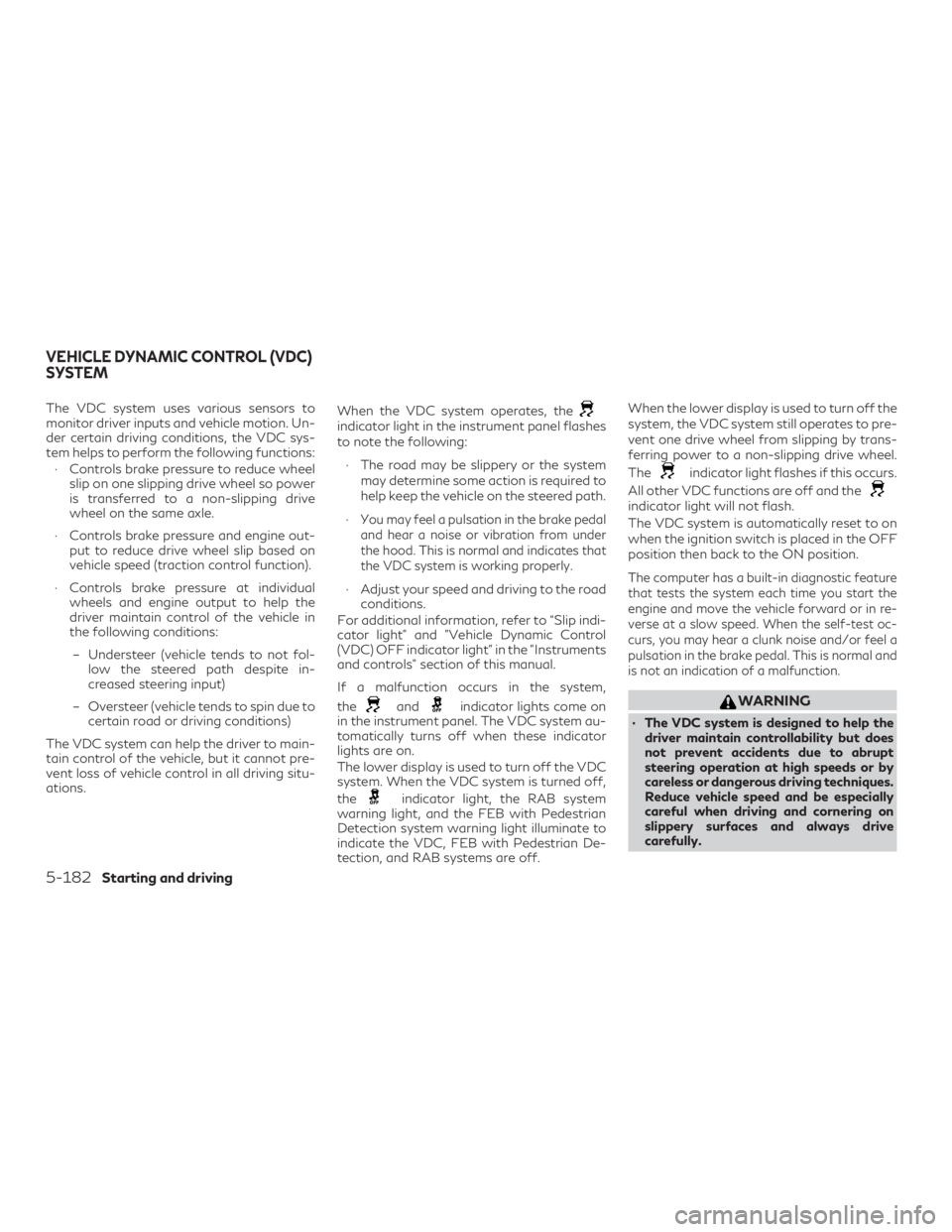
The VDC system uses various sensors to
monitor driver inputs and vehicle motion. Un-
der certain driving conditions, the VDC sys-
tem helps to perform the following functions:∙ Controls brake pressure to reduce wheel slip on one slipping drive wheel so power
is transferred to a non-slipping drive
wheel on the same axle.
∙ Controls brake pressure and engine out- put to reduce drive wheel slip based on
vehicle speed (traction control function).
∙ Controls brake pressure at individual wheels and engine output to help the
driver maintain control of the vehicle in
the following conditions:
– Understeer (vehicle tends to not fol- low the steered path despite in-
creased steering input)
– Oversteer (vehicle tends to spin due to certain road or driving conditions)
The VDC system can help the driver to main-
tain control of the vehicle, but it cannot pre-
vent loss of vehicle control in all driving situ-
ations. When the VDC system operates, the
indicator light in the instrument panel flashes
to note the following:
∙ The road may be slippery or the system may determine some action is required to
help keep the vehicle on the steered path.
∙
You may feel a pulsation in the brake pedal
and hear a noise or vibration from under
the hood. This is normal and indicates that
the VDC system is working properly.
∙ Adjust your speed and driving to the road conditions.
For additional information, refer to “Slip indi-
cator light” and ”Vehicle Dynamic Control
(VDC) OFF indicator light” in the ”Instruments
and controls” section of this manual.
If a malfunction occurs in the system,
the
andindicator lights come on
in the instrument panel. The VDC system au-
tomatically turns off when these indicator
lights are on.
The lower display is used to turn off the VDC
system. When the VDC system is turned off,
the
indicator light, the RAB system
warning light, and the FEB with Pedestrian
Detection system warning light illuminate to
indicate the VDC, FEB with Pedestrian De-
tection, and RAB systems are off. When the lower display is used to turn off the
system, the VDC system still operates to pre-
vent one drive wheel from slipping by trans-
ferring power to a non-slipping drive wheel.
The
indicator light flashes if this occurs.
All other VDC functions are off and the
indicator light will not flash.
The VDC system is automatically reset to on
when the ignition switch is placed in the OFF
position then back to the ON position.
The computer has a built-in diagnostic feature
that tests the system each time you start the
engine and move the vehicle forward or in re-
verse at a slow speed. When the self-test oc-
curs, you may hear a clunk noise and/or feel a
pulsation in the brake pedal. This is normal and
is not an indication of a malfunction.
WARNING
∙ The VDC system is designed to help the driver maintain controllability but does
not prevent accidents due to abrupt
steering operation at high speeds or by
careless or dangerous driving techniques.
Reduce vehicle speed and be especially
careful when driving and cornering on
slippery surfaces and always drive
carefully.
VEHICLE DYNAMIC CONTROL (VDC)
SYSTEM
5-182Starting and driving
Page 447 of 580
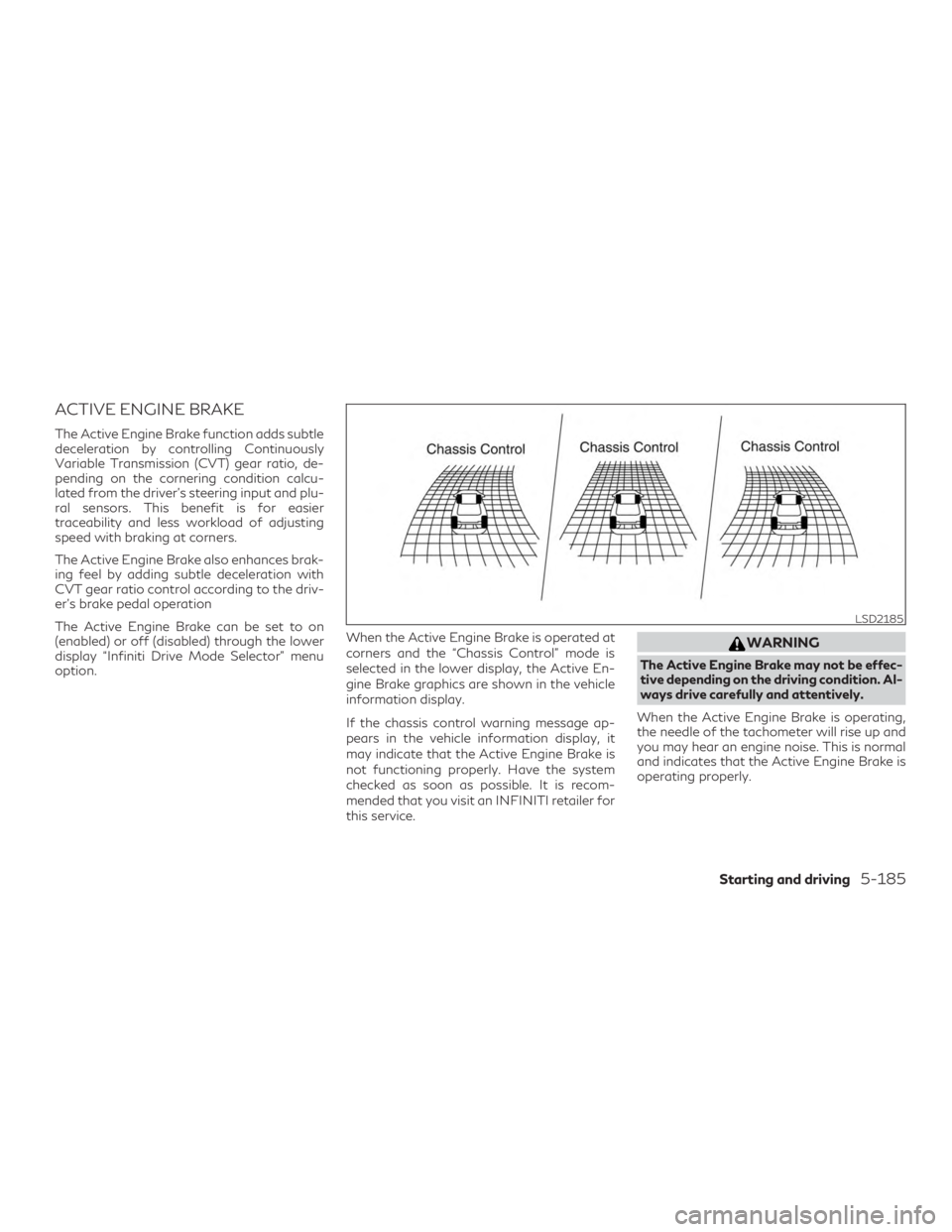
ACTIVE ENGINE BRAKE
The Active Engine Brake function adds subtle
deceleration by controlling Continuously
Variable Transmission (CVT) gear ratio, de-
pending on the cornering condition calcu-
lated from the driver’s steering input and plu-
ral sensors. This benefit is for easier
traceability and less workload of adjusting
speed with braking at corners.
The Active Engine Brake also enhances brak-
ing feel by adding subtle deceleration with
CVT gear ratio control according to the driv-
er’s brake pedal operation
The Active Engine Brake can be set to on
(enabled) or off (disabled) through the lower
display “Infiniti Drive Mode Selector” menu
option.When the Active Engine Brake is operated at
corners and the “Chassis Control” mode is
selected in the lower display, the Active En-
gine Brake graphics are shown in the vehicle
information display.
If the chassis control warning message ap-
pears in the vehicle information display, it
may indicate that the Active Engine Brake is
not functioning properly. Have the system
checked as soon as possible. It is recom-
mended that you visit an INFINITI retailer for
this service.
WARNING
The Active Engine Brake may not be effec-
tive depending on the driving condition. Al-
ways drive carefully and attentively.
When the Active Engine Brake is operating,
the needle of the tachometer will rise up and
you may hear an engine noise. This is normal
and indicates that the Active Engine Brake is
operating properly.
LSD2185
Starting and driving5-185
Page 449 of 580
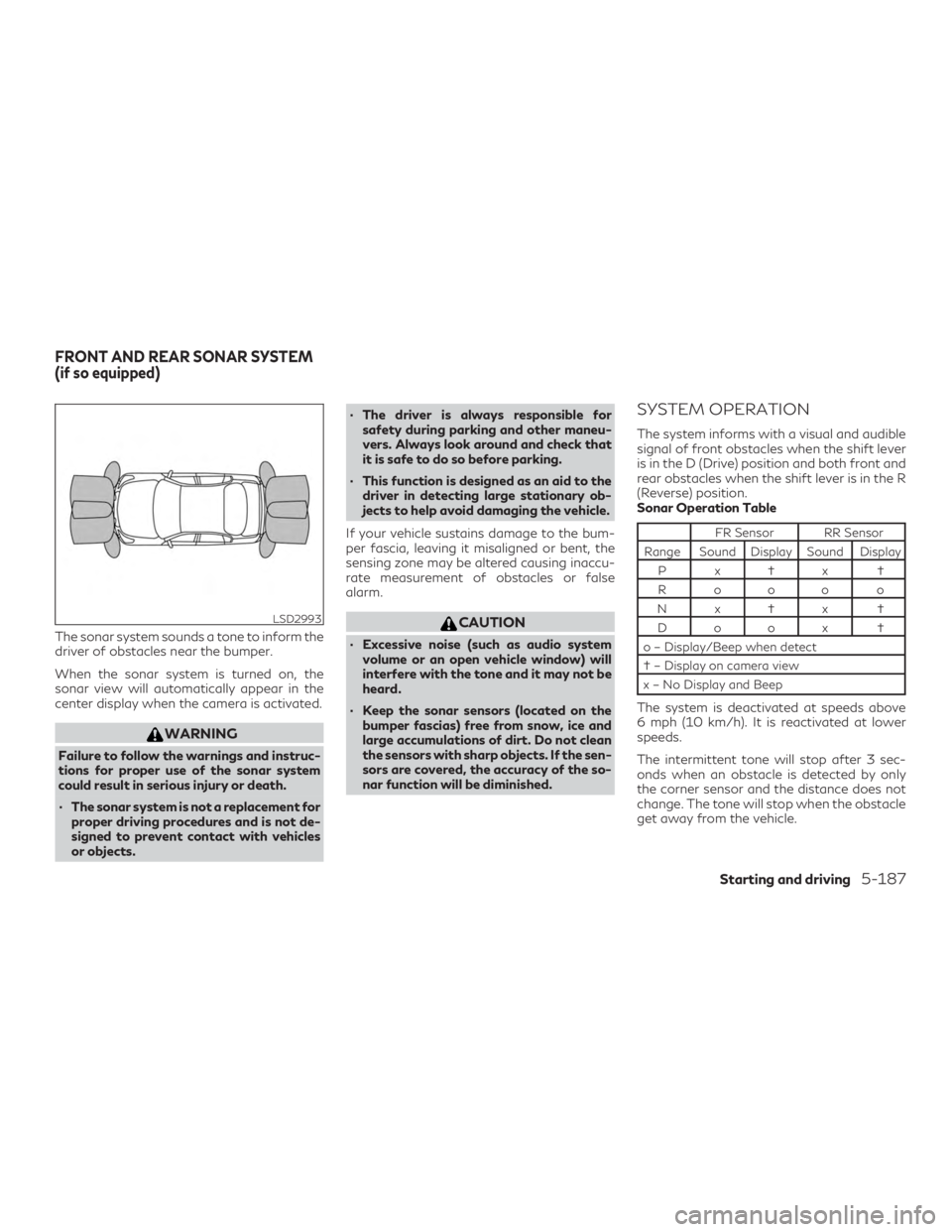
The sonar system sounds a tone to inform the
driver of obstacles near the bumper.
When the sonar system is turned on, the
sonar view will automatically appear in the
center display when the camera is activated.
WARNING
Failure to follow the warnings and instruc-
tions for proper use of the sonar system
could result in serious injury or death.
∙ The sonar system is not a replacement forproper driving procedures and is not de-
signed to prevent contact with vehicles
or objects. ∙ The driver is always responsible for
safety during parking and other maneu-
vers. Always look around and check that
it is safe to do so before parking.
∙ This function is designed as an aid to the driver in detecting large stationary ob-
jects to help avoid damaging the vehicle.
If your vehicle sustains damage to the bum-
per fascia, leaving it misaligned or bent, the
sensing zone may be altered causing inaccu-
rate measurement of obstacles or false
alarm.
CAUTION
∙ Excessive noise (such as audio system volume or an open vehicle window) will
interfere with the tone and it may not be
heard.
∙ Keep the sonar sensors (located on the bumper fascias) free from snow, ice and
large accumulations of dirt. Do not clean
the sensors with sharp objects. If the sen-
sors are covered, the accuracy of the so-
nar function will be diminished.
SYSTEM OPERATION
The system informs with a visual and audible
signal of front obstacles when the shift lever
is in the D (Drive) position and both front and
rear obstacles when the shift lever is in the R
(Reverse) position.
Sonar Operation Table
FR Sensor RR Sensor
Range Sound Display Sound Display Px†x†
R ooo o
Nx†x † Doox †
o – Display/Beep when detect
† – Display on camera view
x–NoDisplayandBeep
The system is deactivated at speeds above
6 mph (10 km/h). It is reactivated at lower
speeds.
The intermittent tone will stop after 3 sec-
onds when an obstacle is detected by only
the corner sensor and the distance does not
change. The tone will stop when the obstacle
get away from the vehicle.
LSD2993
FRONT AND REAR SONAR SYSTEM
(if so equipped)
Starting and driving5-187
Page 452 of 580
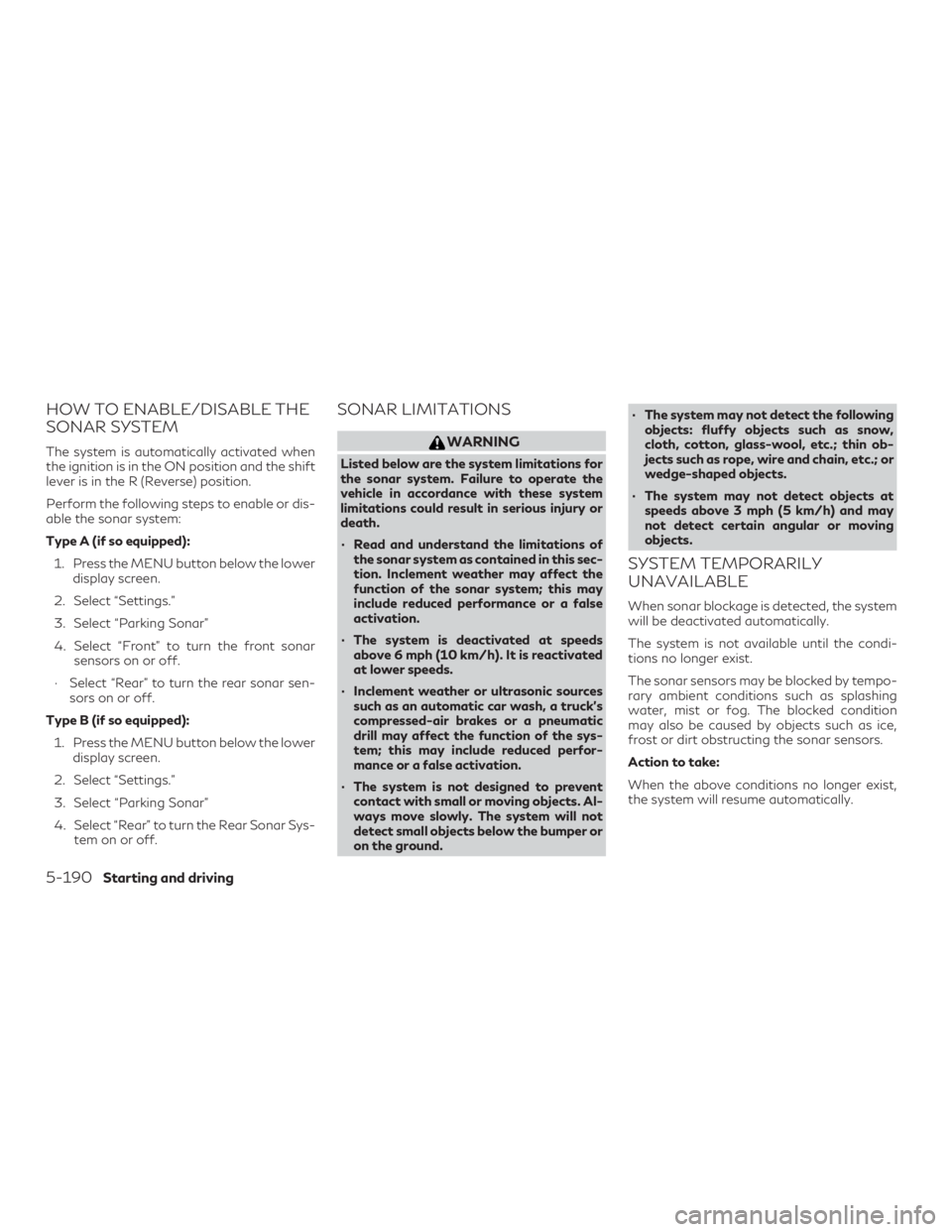
HOW TO ENABLE/DISABLE THE
SONAR SYSTEM
The system is automatically activated when
the ignition is in the ON position and the shift
lever is in the R (Reverse) position.
Perform the following steps to enable or dis-
able the sonar system:
Type A (if so equipped):1. Press the MENU button below the lower display screen.
2. Select “Settings.”
3. Select “Parking Sonar”
4. Select “Front” to turn the front sonar sensors on or off.
∙ Select “Rear” to turn the rear sonar sen- sors on or off.
Type B (if so equipped): 1. Press the MENU button below the lower display screen.
2. Select “Settings.”
3. Select “Parking Sonar”
4. Select “Rear” to turn the Rear Sonar Sys- tem on or off.
SONAR LIMITATIONS
WARNING
Listed below are the system limitations for
the sonar system. Failure to operate the
vehicle in accordance with these system
limitations could result in serious injury or
death.
∙ Read and understand the limitations ofthe sonar system as contained in this sec-
tion. Inclement weather may affect the
function of the sonar system; this may
include reduced performance or a false
activation.
∙ The system is deactivated at speeds above 6 mph (10 km/h). It is reactivated
at lower speeds.
∙ Inclement weather or ultrasonic sources such as an automatic car wash, a truck’s
compressed-air brakes or a pneumatic
drill may affect the function of the sys-
tem; this may include reduced perfor-
mance or a false activation.
∙ The system is not designed to prevent contact with small or moving objects. Al-
ways move slowly. The system will not
detect small objects below the bumper or
on the ground. ∙ The system may not detect the following
objects: fluffy objects such as snow,
cloth, cotton, glass-wool, etc.; thin ob-
jects such as rope, wire and chain, etc.; or
wedge-shaped objects.
∙ The system may not detect objects at speeds above 3 mph (5 km/h) and may
not detect certain angular or moving
objects.
SYSTEM TEMPORARILY
UNAVAILABLE
When sonar blockage is detected, the system
will be deactivated automatically.
The system is not available until the condi-
tions no longer exist.
The sonar sensors may be blocked by tempo-
rary ambient conditions such as splashing
water, mist or fog. The blocked condition
may also be caused by objects such as ice,
frost or dirt obstructing the sonar sensors.
Action to take:
When the above conditions no longer exist,
the system will resume automatically.
5-190Starting and driving
Page 453 of 580

SYSTEM MAINTENANCE
The sonar sensors are located on the front
and rear bumpers. Always keep the area near
the sonar sensors clean.
The sonar sensors may be blocked by tempo-
rary ambient conditions such as splashing
water, mist or fog.
The blocked condition may also be caused by
objects such as ice, frost or dirt obstructing
the sonar sensors.
Check for and remove objects obstructing
the area around the sonar sensors.Do not attach stickers (including transparent
material), install accessories or apply addi-
tional paint near the sonar sensors.
Do not strike or damage the area around the
sonar sensors. It is recommended that you
visit an INFINITI retailer if the area around
the sonar sensors is damaged due to a colli-
sion.
FREEING A FROZEN DOOR LOCK
To prevent a door lock from freezing, apply
de-icer through the key hole. If the lock be-
comes frozen, heat the key before inserting it
into the key hole, or use the INFINITI Intelli-
gent Key.
ANTIFREEZE
In the winter when it is anticipated that the
temperature will drop below 32°F (0°C),
check the antifreeze to assure proper winter
protection. For additional information, refer
to “Engine cooling system” in the “Do-it-
yourself” section of this manual.
BATTERY
If the battery is not fully charged during ex-
tremely cold weather conditions, the battery
fluid may freeze and damage the battery. To
maintain maximum efficiency, the battery
should be checked regularly. For additional
information, refer to “Battery” in the “Do-it-
yourself” section of this manual.
LSD2993
COLD WEATHER DRIVING
Starting and driving5-191
Page 459 of 580
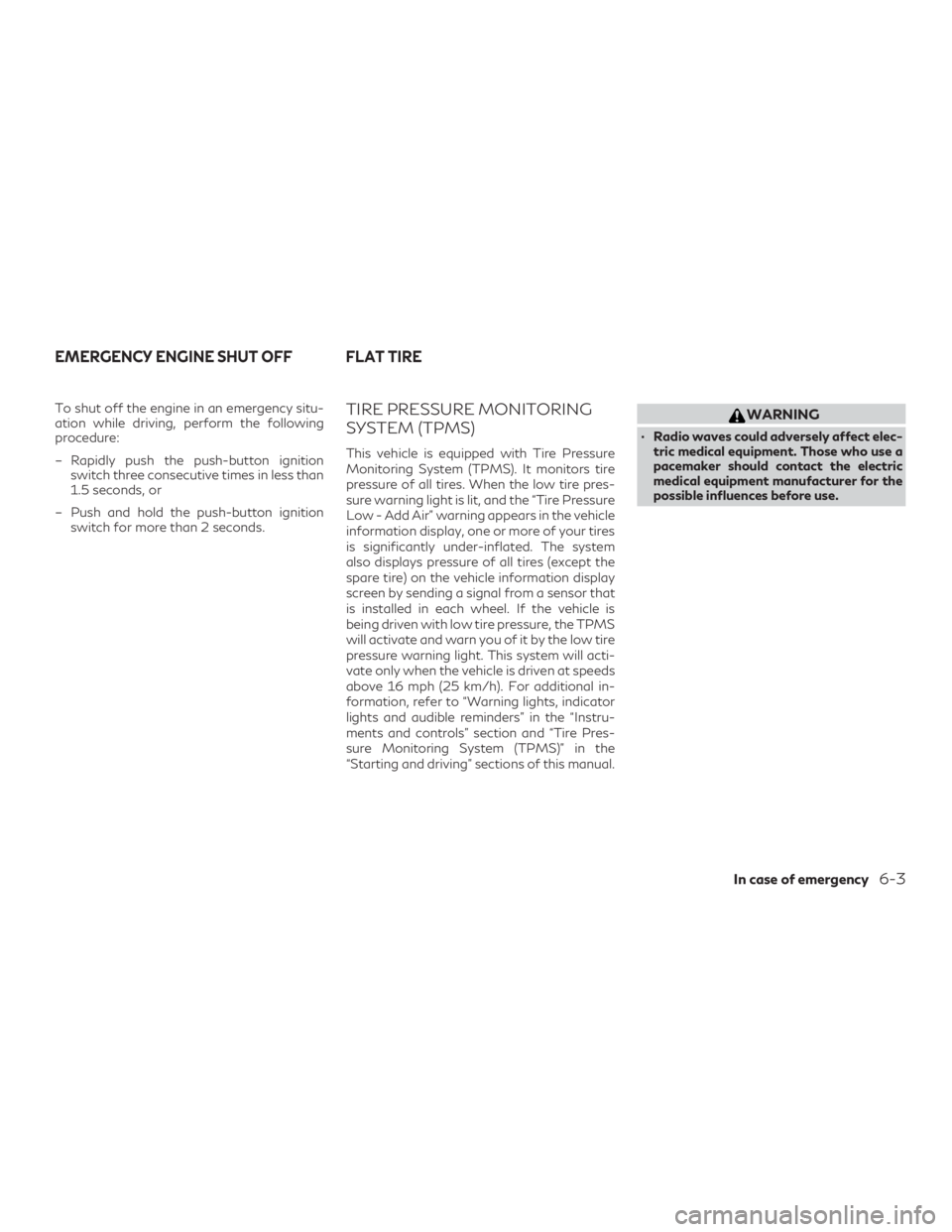
To shut off the engine in an emergency situ-
ation while driving, perform the following
procedure:
– Rapidly push the push-button ignitionswitch three consecutive times in less than
1.5 seconds, or
– Push and hold the push-button ignition switch for more than 2 seconds.TIRE PRESSURE MONITORING
SYSTEM (TPMS)
This vehicle is equipped with Tire Pressure
Monitoring System (TPMS). It monitors tire
pressure of all tires. When the low tire pres-
sure warning light is lit, and the “Tire Pressure
Low - Add Air” warning appears in the vehicle
information display, one or more of your tires
is significantly under-inflated. The system
also displays pressure of all tires (except the
spare tire) on the vehicle information display
screen by sending a signal from a sensor that
is installed in each wheel. If the vehicle is
being driven with low tire pressure, the TPMS
will activate and warn you of it by the low tire
pressure warning light. This system will acti-
vate only when the vehicle is driven at speeds
above 16 mph (25 km/h). For additional in-
formation, refer to “Warning lights, indicator
lights and audible reminders” in the “Instru-
ments and controls” section and “Tire Pres-
sure Monitoring System (TPMS)” in the
“Starting and driving” sections of this manual.
WARNING
∙ Radio waves could adversely affect elec-tric medical equipment. Those who use a
pacemaker should contact the electric
medical equipment manufacturer for the
possible influences before use.
EMERGENCY ENGINE SHUT OFF FLAT TIRE
In case of emergency6-3
Page 460 of 580
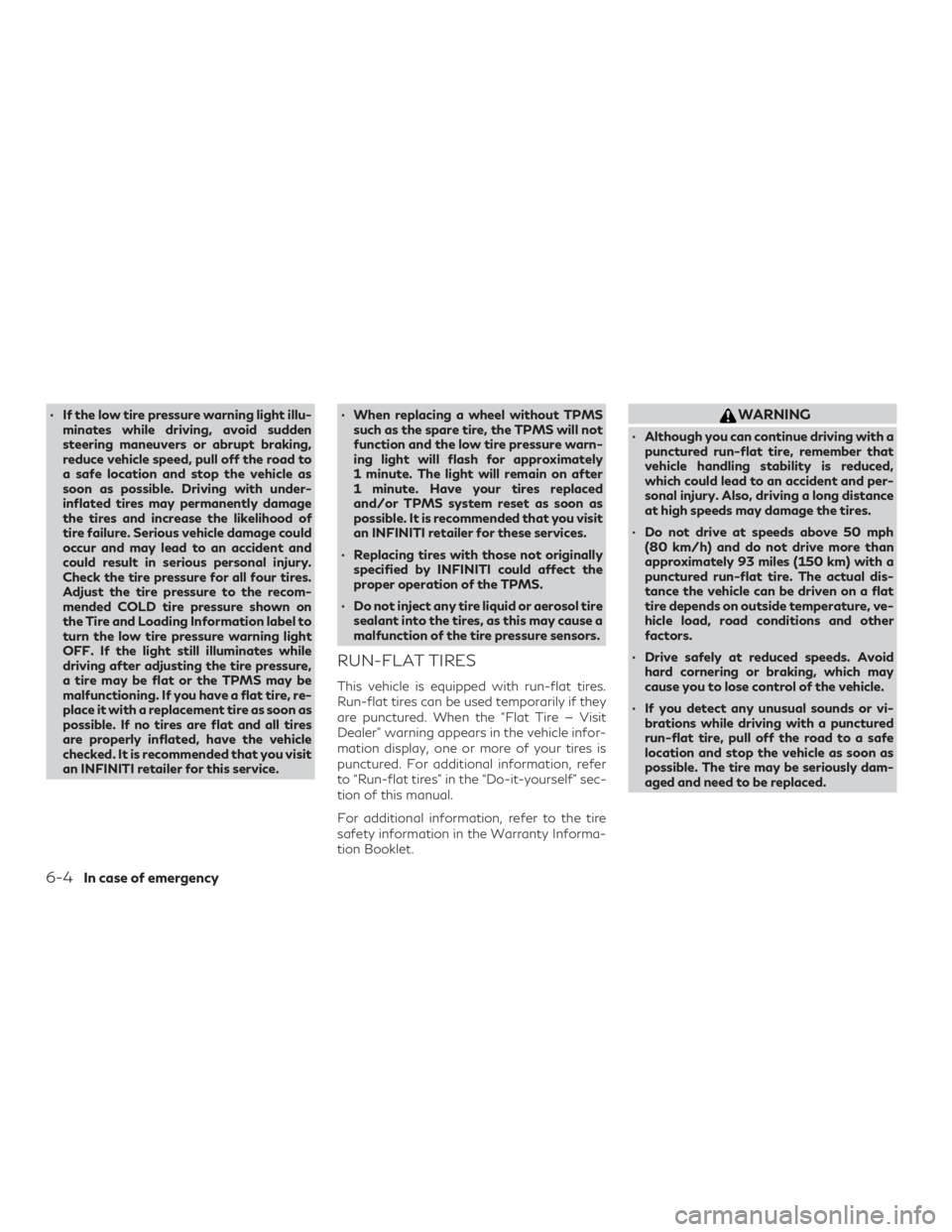
∙ If the low tire pressure warning light illu-minates while driving, avoid sudden
steering maneuvers or abrupt braking,
reduce vehicle speed, pull off the road to
a safe location and stop the vehicle as
soon as possible. Driving with under-
inflated tires may permanently damage
the tires and increase the likelihood of
tire failure. Serious vehicle damage could
occur and may lead to an accident and
could result in serious personal injury.
Check the tire pressure for all four tires.
Adjust the tire pressure to the recom-
mended COLD tire pressure shown on
the Tire and Loading Information label to
turn the low tire pressure warning light
OFF. If the light still illuminates while
driving after adjusting the tire pressure,
a tire may be flat or the TPMS may be
malfunctioning. If you have a flat tire, re-
place it with a replacement tire as soon as
possible. If no tires are flat and all tires
are properly inflated, have the vehicle
checked. It is recommended that you visit
an INFINITI retailer for this service. ∙ When replacing a wheel without TPMS
such as the spare tire, the TPMS will not
function and the low tire pressure warn-
ing light will flash for approximately
1 minute. The light will remain on after
1 minute. Have your tires replaced
and/or TPMS system reset as soon as
possible. It is recommended that you visit
an INFINITI retailer for these services.
∙ Replacing tires with those not originally specified by INFINITI could affect the
proper operation of the TPMS.
∙ Do not inject any tire liquid or aerosol tire sealant into the tires, as this may cause a
malfunction of the tire pressure sensors.
RUN-FLAT TIRES
This vehicle is equipped with run-flat tires.
Run-flat tires can be used temporarily if they
are punctured. When the “Flat Tire — Visit
Dealer” warning appears in the vehicle infor-
mation display, one or more of your tires is
punctured. For additional information, refer
to “Run-flat tires” in the “Do-it-yourself” sec-
tion of this manual.
For additional information, refer to the tire
safety information in the Warranty Informa-
tion Booklet.
WARNING
∙ Although you can continue driving with apunctured run-flat tire, remember that
vehicle handling stability is reduced,
which could lead to an accident and per-
sonal injury. Also, driving a long distance
at high speeds may damage the tires.
∙ Do not drive at speeds above 50 mph (80 km/h) and do not drive more than
approximately 93 miles (150 km) with a
punctured run-flat tire. The actual dis-
tance the vehicle can be driven on a flat
tire depends on outside temperature, ve-
hicle load, road conditions and other
factors.
∙ Drive safely at reduced speeds. Avoid hard cornering or braking, which may
cause you to lose control of the vehicle.
∙ If you detect any unusual sounds or vi- brations while driving with a punctured
run-flat tire, pull off the road to a safe
location and stop the vehicle as soon as
possible. The tire may be seriously dam-
aged and need to be replaced.
6-4In case of emergency
Page 470 of 580

In order to maintain the appearance of your
vehicle, it is important to take proper care of
it.
To protect the paint surfaces, wash your ve-
hicle as soon as you can:∙ After a rainfall to prevent possible dam- age from acid rain.
∙ After driving on coastal roads.
∙ When contaminants such as soot, bird droppings, tree sap, metal particles or
bugs get on the paint surface.
∙ When dust or mud builds up on the sur- face.
Whenever possible, store or park your vehicle
inside a garage or in a covered area.
When it is necessary to park outside, park in a
shady area or protect the vehicle with a body
cover.
Be careful not to scratch the paint surface
when putting on or removing the body cover.WASHING
Wash dirt off with a wet sponge and plenty
of water. Clean the vehicle thoroughly using a
mild soap, a special vehicle soap or general
purpose dishwashing liquid mixed with clean,
lukewarm (never hot) water.
CAUTION
∙ Do not concentrate water spray directly on the sonar sensors (if so equipped) on
the bumper as this will result in damage
to the sensors. Do not use pressure wash-
ers capable of spraying water over
1,200 psi (8,274 kPa) to wash your ve-
hicle. Use of high-pressure washers over
1,200 psi (8,274 kPa) can result in dam-
age to or removal of paint or graphics.
Avoid using a high-pressure washer
closer than 12 inches (30 cm) to the ve-
hicle. Always use a wide-angle nozzle
only, keep the nozzle moving and do not
concentrate the water spray on any one
area. ∙ Do not use car washes that use acid in the
detergent. Some car washes, especially
brushless ones, use some acid for clean-
ing. The acid may react with some plastic
vehicle components, causing them to
crack. This could affect their appearance,
and also could cause them not to function
properly. Always check with your car
wash to confirm that acid is not used.
∙ Do not wash the vehicle with strong household soap, strong chemical deter-
gents, gasoline or solvents.
∙ Do not wash the vehicle in direct sunlight or while the vehicle body is hot, as the
surface may become water-spotted.
∙ Avoid using tight-napped or rough cloths, such as washing mitts. Care must
be taken when removing caked-on dirt or
other foreign substances so the paint
surface is not scratched or damaged.
Rinse the vehicle thoroughly with plenty of
clean water.
Inside edges, seams and folds on the doors,
hatches and hood are particularly vulnerable
to the effects of road salt. Therefore, these
areas must be cleaned regularly. Take care
that the drain holes in the lower edge of the
CLEANING EXTERIOR
7-2Appearance and care